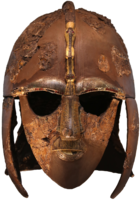
Photo from wikipedia
Background: The helmet worn after sagittal strip craniectomy must be customized to the surgical procedure and the patient’s anatomy to achieve optimal outcomes. This study compares three-dimensional head shape outcomes… Click to show full abstract
Background: The helmet worn after sagittal strip craniectomy must be customized to the surgical procedure and the patient’s anatomy to achieve optimal outcomes. This study compares three-dimensional head shape outcomes obtained from a novel virtual helmet design and from a traditional helmet design. Methods: Twenty-four patients underwent extended sagittal strip craniectomy performed by a single surgeon and helmet management performed by a single orthotist. Eleven patients constitute the traditional helmet group, with helmet design based on laser scans. Thirteen patients constitute the virtual helmet group, with helmet design based on an overlay of a three-dimensional volume rendering of a low-radiation protocol computed tomographic scan and three-dimensional photograph. Cephalic index and vertical height were recorded from three-dimensional photographs. Three-dimensional whole-head composite images were generated to compare global head shape outcomes to those of age-matched controls. Results: There was no significant difference in mean cephalic index between the virtual helmet group (83.70 ± 2.33) and controls (83.53 ± 2.40). The differences in mean cephalic index between the traditional helmet group (81.07 ± 3.37) and controls and in mean vertical height were each significant (p < 0.05). Three-dimensional analysis demonstrated normal biparietal and vertical dimensions in the virtual helmet group compared to controls. The traditional helmet group exhibited narrower biparietal dimension and greater vertical dimension compared to controls. Conclusions: Traditional and virtual helmet protocols improved mean cephalic index, but the virtual helmet group yielded more consistent and greater change in cephalic index. The virtual helmet design protocol yielded three-dimensional outcomes similar to those of age-matched controls. Traditional helmet design yielded a narrower biparietal dimension and greater vertical dimension to the cranial vault compared to the virtual helmet group and controls. CLINICAL QUESTION/LEVEL OF EVIDENCE: Therapeutic, III.
Journal Title: Plastic and Reconstructive Surgery
Year Published: 2021
Link to full text (if available)
Share on Social Media: Sign Up to like & get
recommendations!